|
|
Post by racket on Apr 26, 2011 19:48:49 GMT -5
Hi Anders
If an injector blocks we end up feeding more fuel to the remaining injectors to obtain the required T I T , this will produce "hot and cold" segments on the NGV , potentially causing problems , thankfully our NGVs are pretty robust so there shouldn't be a lot of trouble , but best if it doesn't happen , if a few adjoining injectors get blocked then it can be a real problem ....................I've always been worried about getting rubbish in plumbing as we tend to fit and remove bits several times during a build to check if everythings going to fit , a recipe for troubles :-(
Mmmm , not sure about having the glowplug in the end cap , it could be exposed to liquid hitting it if opposite an injector outlet , also the F/A ratio at the wall could be too rich for combustion , you might need to position it just to the side of the propane injected evaporator so that mixture strength is correct , but could simply be a case of adjusting propane flow to get a combustable mix , maybe half way between an evap with propane and it next door neighbour that doesn't have propane .
Flametube lids invariably run relatively cool due to unvapourised fuel spray hitting it and combustion not occuring until some distance "rearwards" .
LOL, ..................if you ain't spinning that engine around before July , I'll have to go and "kick your ass " ;-)
Cheers
John
|
|
|
|
Post by Johansson on Apr 27, 2011 1:54:57 GMT -5
Hmm, that sounds like a diaster waiting to happen if I don´t make sure the injectors are kept clean. Easier said than done when the workshop is covered in metal grinding dust...  I´ll give it a good cleaning with shop air and the vaccum cleaner and finish off with a litre of methanol pumped through it before the final assembly. I´ll do some more research about the glow plugs, I have megabytes of writings from GTBA so there should be much food for thought in those papers. The thing is that we are just about to buy a house and move out of our rental apartment, so the workshop hours might be a bit reduced until I get settled in in my new workshop. I´ll do my best to get the bits and pieces together on the engine so you won´t have to come over and open a can of woop-ass on me. ;D |
|
|
|
Post by racket on Apr 27, 2011 4:09:09 GMT -5
Hi Anders
Sounds like your workshop is as clean as mine :-(
Thats good news that you'll have a permanent home , you need it with a young family , hope the move goes smoothly :-)
Cheers
John
|
|
|
|
Post by Johansson on Apr 28, 2011 1:41:15 GMT -5
He he, we are the rulers of chaos John. ;D I made the impingement nozzle and some gaskets for the turbine housing yesterday. 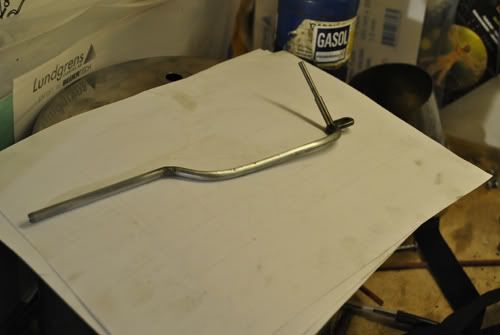 The thin, long stainless impingement nozzle goes through the flame tube wall and NGV and points directly at the turbine wheel blade tips, hopefully it will get the turbine up to high enough revs for starting. 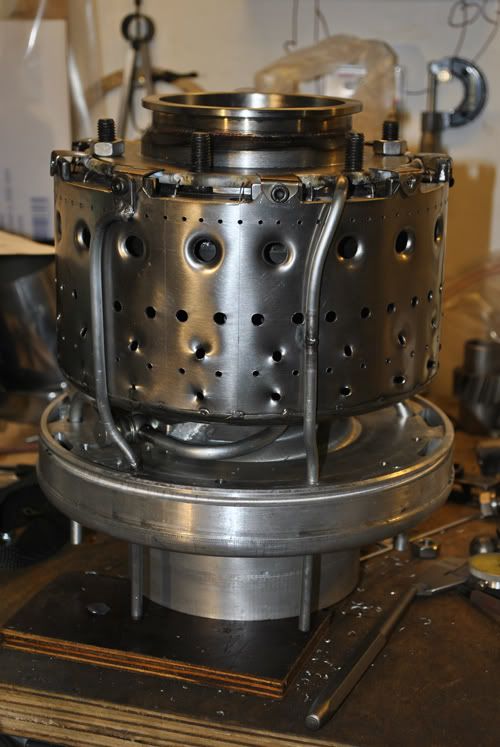 Here you can see a glimpse of the nozzle through one of the vapour tube holes. 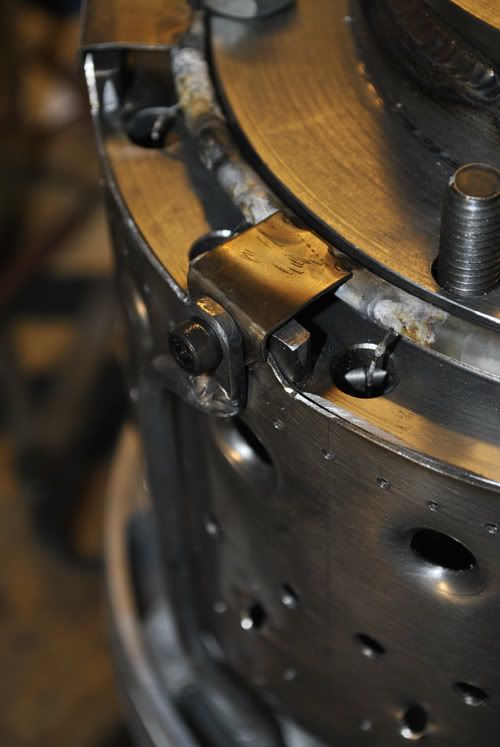 The gaskets were made from a heat resistant material, unfortunately I couldn´t find Klingerit since it contains asbestos but this will most likely do as well. I had to stack three on top of each other to get enough clearance between the engine cover and the fuel manifold/flame tube bolts. 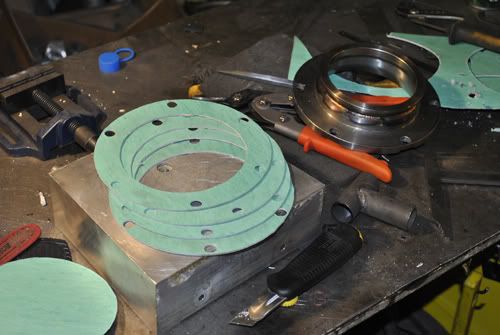 In place on the turbine exducer cover.  A pic of the front plate with all the connections going through it, later a P2 line will be fitted to it and perhaps a cable inlet for a spark plug depending on if I will fit it internally or externally. I haven´t decided on that one yet. 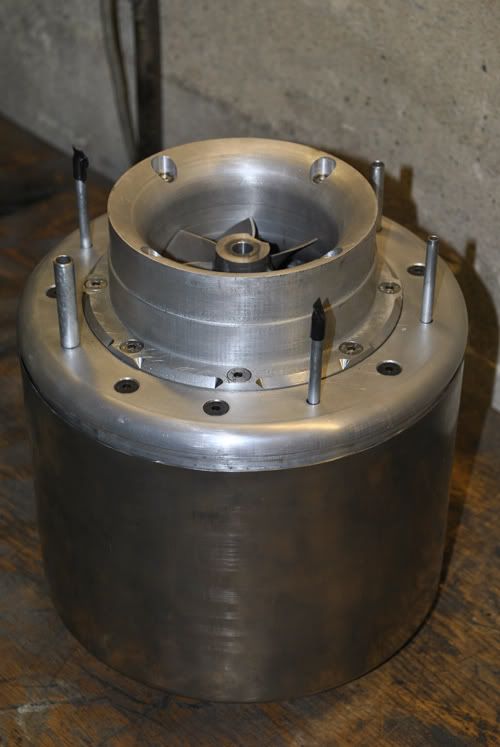 Cheers! |
|
|
|
Post by Johansson on Apr 28, 2011 15:01:40 GMT -5
I have been thinking about the ignition and I think that a spark plug with the threaded mount welded to the engine housing will be the wisest choice, I would have prefered to hide it inside the engine but in case I have problems igniting the propane I would have to take the engine apart to see if the plug was working. Not exactly practical...  The idea is to take enough threads away so the spark plug can be fitted to the centre electrode reches down into one of the dillution holes without restricting the air flow, since they are bellmouthed the spark will be somewhat inside the flame tube. (the flame tube will act as the negative electrode) |
|
|
|
Post by racket on Apr 28, 2011 15:57:03 GMT -5
Hi Anders
The further "down" the flametube you position the ignitor the greater the amount of combustable mix you'll have when it does ignite , it could be a violent bang with a gut full of propane mix , probably safer to have it close to one of the evaporator outlets being fed preheat gas , you'll get a softer ignition and possibly a more reliable ignition , it looks like most of the micro engines have it positioned in the primary and up to secondary zone, ................there could be a good reason for doing so :-)
Cheers
John
|
|
|
|
Post by ernie wrenn on Apr 28, 2011 16:34:06 GMT -5
Depending on the length needed on the spark plug... We switched over to spark plugs for outboard 2 stroke motors. They are surface gap and tend not to foul. Also no sharp hot areas to worry about or electrodes to melt off and fall in the engine.
Ernie
|
|
|
|
Post by Johansson on Apr 29, 2011 0:01:19 GMT -5
That is true, the kick engine with its large flame tube and spark plug fitted at the bend before the turbine inlet produce some mighty fine bangs sometimes when ignition occurs... ;D
I´ll use one of the primary zone holes then, thanks for the pointer.
Ernie, what is the diameter of the tip of that plug? In this case a center electrode is useful since it can be put inside a flame tube hole so the sparks jump from electrode to the side of the hole.
|
|
|
|
Post by racket on Apr 29, 2011 0:50:34 GMT -5
Hi Anders
One thing you need to consider , the ignitor on most turbine engines is fairly well "sealed" so that air bypassing it can't blow any combustable mix away from the spark .
I normally have my plug length "adjusted" so that the ~14mm dia face is pressed hard against the flametube wall to prevent air getting around it and entering the flametube and blowing the fuel away from the plug .
I roughly position my plug thread in the outer can wall in a spot where there aren't any flametube holes , then with the flametube mounted in place and the outer can also , I screw in a "projecting type" plug which has the earth removed and the centre electrode sharpened to a point , the "centre punch" electrode neatly provides a mark to subsequently drill the ~12mm dia hole for the ignitors electrode to fit thru .
Cheers
John
|
|
|
|
Post by Johansson on Apr 29, 2011 1:04:37 GMT -5
Great advice! The blowing away of fuel from the spark plug is something I have never thought about, there is no risk of overheating the electrode without the cooling air around it?
How do your plug fitting cope with the flame tube expansion when it is pressed against it?
|
|
|
|
Post by ernie wrenn on Apr 29, 2011 7:55:41 GMT -5
I cut and wielded a "spark plug anti fouling adapter " in place. They are cheap at the auto part stores and save a lot of time.
Take a look at the flame tube I built for the hearse. That complete assembly can be cut WAY down and you will not need the ignition fuel section.
Ernie
|
|
|
|
Post by Johansson on Apr 29, 2011 13:08:49 GMT -5
Will do, I have to check up the anti fouling thingie since I´ve never heard about something like that before.  |
|
|
|
Post by racket on Apr 29, 2011 20:48:04 GMT -5
Hi Anders
There hasn't been any problems with plugs from this method of mounting , the FT will expand radially, but only by a millimetre or so, and it appears as though there is sufficient flex in its wall to cope with any loads, if in doubt position the plug end so that its end is barely touching the FT wall.
Once I've determined a position for the plug , I drill thru the outer can wall and using the vernier measure the distance from OD to OD and workout the dimensions of the threaded boss I need to machine up so that the plugs end just touches the FT wall , its a pretty straight forward job , once made, I silver solder it in position , I don't weld it as that produces stresses and can warp the boss .
Out of position axial movement is rather limited due to the small distances involved , maybe 0.5-1 mm , well withing the clearance distance between the ~6mm dia centre electrode and FT wall when using a 9-10mm dia hole .
I only use old second hand long reach car plugs that have already done 40,000 ks, just grind off the earth "thingo" and ready to use :-)
Plug ends can be machined to "fit??" if need be .
One thing to be beware of is the amount of boss projecting inside the outer can , not so much as to foul anything during assembly/disassembly , but enough to provide a reasonable amount of thread for torquing , I invariably have some thread projecting from my bosses which generally end several millimetres from the FT wall
Cheers
John
|
|
|
|
Post by ernie wrenn on Apr 30, 2011 10:41:21 GMT -5
We built a ignitor using the electrode out of a torpedo shop heater. the electrode is approx 6 inches long and screws in a spark plug holder. we cut the ground strap off and used the combuster chamber for the ground.
look back on my hearse project page 2, it shows sthe antifoul adapters i used on the J-34.
Ernie
|
|
|
|
Post by Johansson on May 1, 2011 1:23:00 GMT -5
I think I´ll follow Johns line here, sounds like the easiest route since I have car plugs at home.  |
|